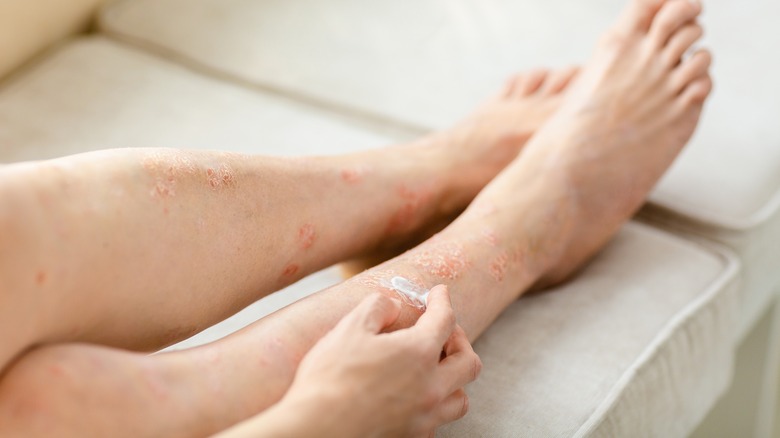What It Means When You Have Hair Loss On Your Legs
You're sliding your pants up and notice a patch of smooth skin near your knee. You don't think anything of it; but, over the next few weeks, the bald patch has accumulated a few friends. Hair loss on the legs can happen at any time in your life, but it is more common in men than women. It also has various causes that are important to investigate thoroughly.
Anterolateral leg alopecia is a type of hair loss on the legs common in middle-aged to older men, according to a 2014 study in the International Journal of Trichology. It's typically limited to the inside and outside of both legs and doesn't appear as baldness on other parts of the body.
One of the most common causes of hair loss in any area of the body is alopecia areata. This condition occurs when the body's immune system confuses the hair follicles for invaders and attacks them. The American Academy of Dermatology Association states that hair loss can be limited to your scalp or universal, depending on what area of the body is affected. The form that causes complete hair loss all over your body is known as "alopecia universalis."
Beyond these common causes of hair loss, there are other factors that can create bald spots on the legs. Put your mind at ease by knowing the causes of leg hair loss and when you should talk to your doctor.
Peripheral artery disease
Small patches of hairlessness might go unnoticed on your legs, or you might assume it's from the rubbing of your pants. But when you notice several bald patches on your legs, it might be time to talk to your healthcare professional to check for peripheral artery disease (PAD).
This condition causes a blockage of the arteries that supply the legs with blood, states the USA Vascular Centers. The narrowed arteries have trouble keeping the blood oxygenated in the legs and can cause pain, cramps, ulcers on the legs and feet, and numbness. If left untreated, blocked arteries can lead to a heart attack or stroke in some individuals, according to the Centers for Disease Control and Prevention.
Medical News Today also states that men have slightly more risk than women of developing PAD. This might help account for why leg hair loss is 35% more likely in men than women (per The International Journal of Trichology). It might also be that women notice the condition less due to shaving.
Hormonal disorders
The National Diabetes Statistics Report indicates that 37.3 million people in the U.S. (11% of the population) live with diabetes (via Centers for Disease Control and Prevention). Diabetes is a chronic medical condition where either the pancreas doesn't produce insulin properly (type 1 diabetes) or the body is unable to properly utilize the insulin that it does make (type 2 diabetes), leading to higher-than-normal blood sugar levels. Medical News Today notes that over time, diabetes can damage the blood vessels, reducing blood flow to the legs. This can cause those with diabetes to experience a loss of hair on their legs.
Like diabetes, thyroid disease is a chronic condition that requires a lifetime of medication for most individuals. Diseases of the thyroid cause it to make too much or too little hormone, states the Cleveland Clinic. The leg hair loss from an overactive or underactive thyroid isn't due to damage to the vessels but how the thyroid affects hair growth since one of the many areas that the thyroid gland affects is the hair follicles. According to the British Thyroid Foundation, a disruption in the system can lead to bald patches on your legs. Getting treatment for a thyroid disorder can help regulate your hormone levels and bring with it regrowth. Therefore, you'll want to check with your healthcare practitioner for unusual leg hair loss.
Inflammatory skin conditions
Your skin is the landscape that houses your hair follicles. If they are experiencing any issues, then baldness can ensue. Eczema is an inflammatory skin condition that causes rashes, dry skin, and scaly skin, according to the National Eczema Foundation. On the other hand, psoriasis is an immune disorder that causes inflammation in the body (per National Psoriasis Foundation). A malfunction of the immune system leads to overactive skin growth, causing raised plaques on the skin's surface. The inflamed and unhealthy skin environment can make it hard for hair follicles to thrive, leading to hair loss on the legs and feet. Treating the conditions with creams and keeping the skin supple can trigger hair regrowth.
Inflammation of the skin can also come from different infections. WebMD notes that fungal infections like ringworm can cause round-shaped bald spots on the body. The fungus can even get into the hair shaft and cause the hair to break off until the infection is treated with an antifungal medication. Additionally, when bacteria find their way into the hair shafts, it can cause follicle infections (known as folliculitis), which might destroy the hair follicles if not treated. In addition to hair loss, you might notice pimple-like sores and itching if folliculitis is at play. Treatment for skin conditions is necessary to help your leg hair regrow.
Other possible causes of leg hair loss
If you start losing patches of hair on the side of your calf or near your shin, you might want to weed out any diseases or conditions like those mentioned above. However, diseases aren't the only things that might lead to hair loss on your toes or ankles. You might also be experiencing hair loss in specific locations due to your pants or socks rubbing. For example, those who are die-hard sock wearer, even with sandals, might find that the leg on their ankles and upper calves is pretty bare.
Medical News Today notes that nutritional deficiencies, like iron or zinc, could also be the cause of leg hair loss. If your diet is poor or you have a medical condition that might contribute to nutritional deficiencies, this could be causing your hair loss.
It can also be beneficial to take a look at your medications. Medical News Today notes that amphetamines, antidepressants, beta-blockers, and cholesterol-lowering medications can lead to leg hair loss. Medications to treat high blood pressure, specifically ACE inhibitors, might also be the culprit. Additionally, a 2014 study in Clinical Infectious Diseases states that alopecia was reported in 82% of patients taking voriconazole for fungal infections.





